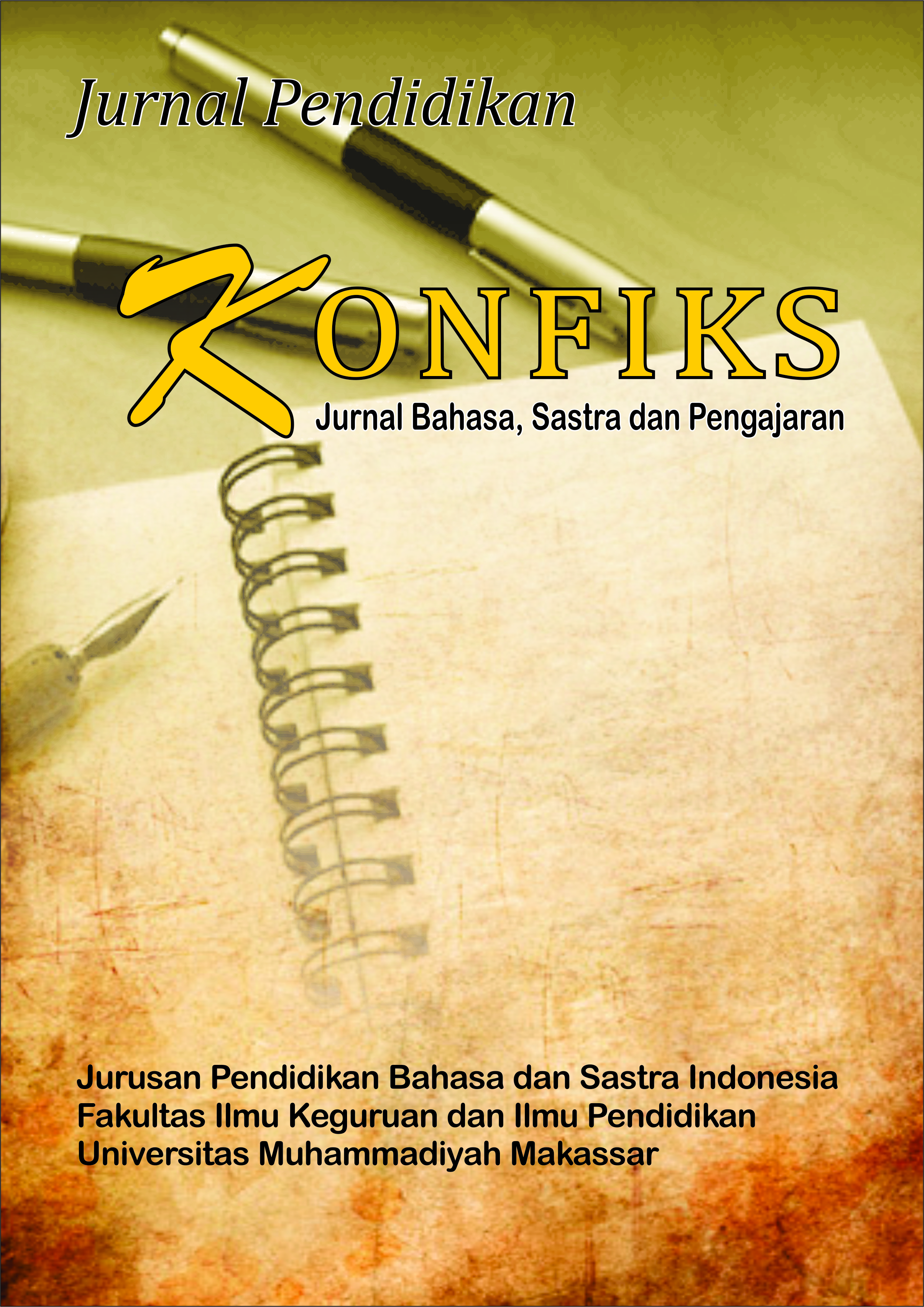KEEFEKTIVAN STRATEGI BRAINSTORMING DALAM PEMBELAJARAN MENULIS PARAGRAF ARGUMENTASI SISWA KELAS XI SMA NEGERI 1 BONTONOMPO KABUPATEN GOWA
DOI:
https://doi.org/10.26618/konfiks.v2i2.415Abstract
Abstract
Essay writing skills will not happen by it self, but requires continuous coaching and training, continuous, and performed as a process of development. For the purpose of writing essay was achieved with good arguments, then teaching essay writing arguments should be sought to be gradual and planned. This study aims to determine the effectiveness of brainstorming strategies in teaching students to write a paragraph argumentation class XI SMA Negeri 1 Bontonompo Gowa. The study design used a quasi-experimental nature. The study population was the overall Class XI student of SMAN 1 Bontonompo Gowa. The study sample consisted of two classes, namely VIIIA grade students as an experimental class and grade students VIIIB as the control class. The technique used in this study is a written test, while the technique of data analysis using statistical techniques of descriptive and inferential statistics. Results of the ability to write a paragraph argumentation by applying the experimental class brainstorming strategy shows the average value of students after having a treatment reached 78.87, while in the control group after treatment or action held by applying conventional learning in writing paragraph Argumentsi only reached 73.80. The results ofinferential analysis using the t test calculations, it appears thatthe application of effective brainstorming strategies applied in teachingessay writing paragraphs argument GradeXI SMAN 1Bontonompo Gowa. It was based on the resultstcount of2,187 compared with 2,002 ttable with a significant level of0.033. This means Ho rejected and H1 accepted. In accordance with the results of the research, it can be concluded that effectivebrainstorming strategies applied in teaching writing paragraphs argument Grade XISMAN 1 Bontonompo Gowa.
Keywords : Brainstorming Strategies, and Writing Argument Paragraph
Abstrak
Kemampuan menulis karangan tidak akan terjadi dengan sendirinya, tetapi memerlukan pembinaan dan latihan terus menerus, berkesinambungan, dan dilakukan sebagai proses pengembangan. Agar tujuan menulis karangan argumentasi itu tercapai dengan baik, maka pengajaran menulis karangan argumentasi harus diupayakan untuk dilakukan secara bertahap dan berencana.
Penelitian ini bertujuan untuk mengetahuikeefektivan strategibrainstorming dalam pembelajaran menulis paragrafargumentasi siswakelas XI SMA Negeri 1Bontonompo Kabupaten Gowa.Desain penelitian yang digunakan bersifat eksperimen semu. Populasi penelitian ini adalah keseluruhan Siswa Kelas XI SMA Negeri 1Bontonompo Kabupaten Gowa. Sampel penelitian ini terdiri atas dua kelas, yaitu siswa kelas VIIIA sebagai kelas eksperimen dan siswa kelas VIIIB sebagai kelas kontrol. Teknik yang digunakan dalam penelitian ini adalah tes tertulis, sedangkan teknik analisis data menggunakan teknik statistik deskriptif dan statistik inferensial.
Hasil kemampuan menulis paragraf argumentasidengan menerapkan strategi brainstormingpada kelas eksperimen menunjukkan nilai rata-rata siswa setelah diadakan perlakuan mencapai 78,87, sedangkan pada kelas kontrol setelah diadakan perlakukan atau tindakan dengan menerapkan pembelajaran konvensional dalam menulis Paragraf Argumentsi hanya mencapai 73,80.
Hasil analisis inferensial dengan menggunakan perhitungan uji t, tampak bahwa penerapan strategi brainstormingefektif diterapkan dalam pembelajaran menulis karangan ParagrafArgumentasi Siswa Kelas XI SMA Negeri 1Bontonompo Kabupaten Gowa. Hal ini berdasarkan hasil thitung sebesar 2,187 dibandingkan dengan ttabel sebesar 2,002 dengan taraf signifikan 0,033. Hal ini berarti H0 ditolak dan H1 diterima. Sesuai dengan hasil penelitian, dapat disimpulkan bahwa strategi brainstormingefektif diterapkan dalam pembelajaran menulis ParagrafArgumentasi Siswa Kelas XI SMA Negeri 1Bontonompo Kabupaten Gowa
Kata Kunci :Strategi Brainstorming, dan Menulis Paragraf Argumentasi
References
Darmadi. 1996. Meningkatkan Kemampuan Menulis. Yogyakarta: Andi Offset
Enre, Fachruddin Ambo. 1994. Dasar-dasar Keterampilan Menulis. Ujung Pandang: IKIP UJungpandang.
Hernowo. 2004. Langkah Mudah Membuat Buku yang Menggugah. Bandung: MLC.
Ismayani. 2007. Pembinaan Kemampuan Menulis Bahasa Indonesia. Jakarta : Erlangga.
Keraf, Gorys. 2007. Argumentasi dan Narasi. Jakarta: Gramedia Pustaka Utama.
Margono, S. 2007. Metodologi Research. Yogyakarta : FP UGM.
Masyita. 2008. Meningkatkan Kemampuan Menulis Paragraf Argumentasi dengan Menggunakan Metode Brainstorming di SMA Negeri 9 Makassar. Skripsi. Tidak diterbitkan. Makassar : Universitas Negeri Makassar.
Marzuki. 1974. MetodologiRiset. Yogyakarta : FEUII.
Nurudin. 2007. Dasar-dasar Penulisan. Malang: Universitas Negeri Malang.
Rahim, Abd Rahman. 2009. Bina Bahasa. Makassar: UMM.
Pappas. 1994. Menulis . Bandung:Angkasa
Roestiyah. 2008. Strategi Belajar Mengajar. Jakarta: Rineka Cipta.
Subagio. 2002. MetodePenelitiandalamTeori danPraktek.Jakarta : Rineka.
Syafi’ie, Imam. 1998. Retorika dalam Menulis. Jakarta: Depdikbud.
Tarigan, Henry Guntur. 2008. Menulis Sebagai Suatu Keterampilan Berbahasa. Bandung: Angkasa.
Zaenal. 2007. Cermat Berbahasa Indonesia. Jakarta: Akapres
Downloads
Published
Issue
Section
License
Authors who publish with this journal agree to the following terms:
The author owns the copyright and grants the journal rights for first publication with the work simultaneously licensed under a Creative Commons Attribution License which allows others to share the work with acknowledgment of the work's authorship and initial publication in this journal.
Authors may enter into separate additional contractual agreements for the non-exclusive distribution of the published journal version of the work (for example, posting it to an institutional repository or publishing it in a book), with acknowledgment of its initial publication in this journal.
Authors are permitted and encouraged to post their work online (for example, in institutional repositories or on their websites) before and during the submission process, as this can lead to productive exchanges, as well as earlier and larger citations of published work (See The Effect of Open Access).
Statement of Authenticity and Manuscript Copyright can be downloaded: Here
After filling in the statement letter, please send via e-mail: konfiks@unismuh.ac.id

